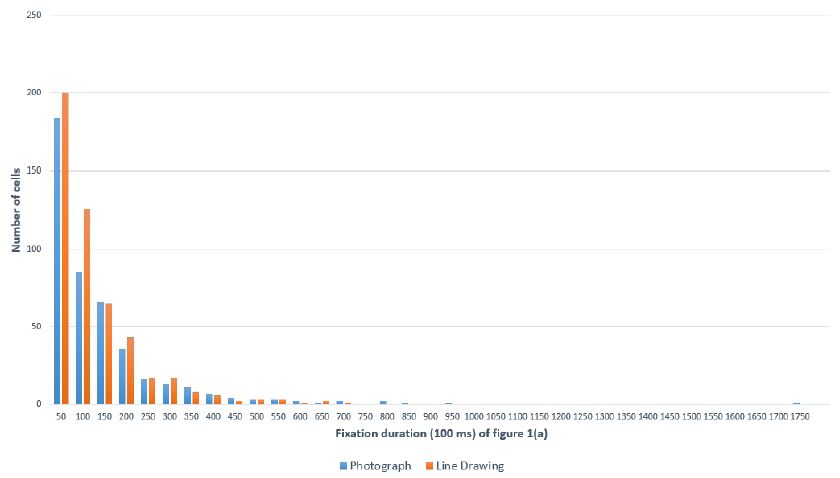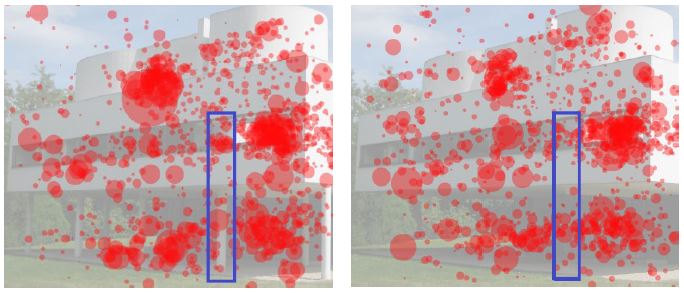
The Impact of Design Representation on Visual Perception: Comparing Eye-Tracking Data of Architectural Scenes Between Photography and Line Drawing
Background Representation in architecture is essential in that most of the design process is performed in representing media. Previous visualization studies have used questionnaires to reveal the relationship between the credibility of representation and high-level features (e.g., accuracy, realism, and abstraction) but had limited impact on the understanding of how people perceive and should produce representations.
Methods In this study, eye-tracking data from six pairs of photographs and line drawing images were used to understand how representations affect people’s perceptions of architectural scenes. The impact of the educational background of the viewer and the sensitivity to a change in the given architectural scene was also investigated.
Results Line drawing, relative to photography, was found to scatter and concentrate attention depending on the means of expression, to reduce the difference in attention between major/non-major groups, and to lessen the shift in attention according to scene changes because of the reduced contextual information.
Conclusions While this study suggests how representational differences may be alleviated through technical means, we also argue that line drawing has a unique potential as a common cognitive ground for more open discussion.
Keywords:
Architectural Design, Design Cognition, Drawings, Perception, Representation1. Introduction
Representation in design helps participants externalize, experience, communicate, and evaluate design ideas throughout the design process. Previous research on design representation has attempted to define its role and best practices in diverse design contexts, and found that sketching works as a dialog between mental and external images (Schön, 1983), the presentation method plays a critical role in conveying design intentions (Jansen et al., 2011), and technology affects every stage of the design process (Kalay, 2006). The status of representation in architectural research is unique among art and design disciplines in that entire process is conducted in representing media (Appleyard, 1977). As 2D media cannot fully represent the scale and dimensions of architectural space, representing the architectural experience has been a main major issue in academic research and field practice (Zobel, 1995). Among the prime achievements of such efforts is perspective line drawing, which has remained in use since its invention during the Italian Renaissance. A seemingly neutral media for projecting the 3D world onto 2D canvases, line drawing has frequently diverged from reality; it increasingly assumed a pleasant and idealized world for marketing purposes (Appleyard, 1977), aroused aesthetic experiences of its own (Bafna, 2008), and pioneered new means of expression for creative minds (Goldschmidt, 2004). Because of such selective and directive nature of representation (De la Fuente Suarez, 2016), line drawing has been the target of research in response equivalence—attempts to reconcile responses to representations with real environments—or visualization—studies on the abilities of visual forms in eliciting certain emotional or evaluative responses (MacFarlane et al., 2005).
While numerous studies on visualization have compared responses to target representations, the methods employed were mostly confined to quantitative perceptual approaches (Downes & Lange, 2015), in which statistical differences were reported based on ratings of candidate features: accuracy, realism, level of abstraction, engagement, and comprehensiveness (Appleyard, 1977; Sheppard, 1989). Although such methodology was helpful in relating various evaluative dimensions to the credibility of a representation, the outcomes didn’t lead to practical standards for the production of visualization (MacFarlane et al., 2005). In other words, guidelines for improved choice, creation, and targeting in architectural representation, along with the perceptual behaviors that ground such a claim, have not been fully investigated (Goldschmidt, 2004; De la Fuente Suarez, 2016). This study aims to reveal how people perceive differently, by focusing on identifying the features of line drawing representation through which the viewer’s perception is (in)advertently influenced.
This study targets two representations of identical architectural scenes, namely, photography and line drawing. In order to quantify the perceptual behavior of the viewers, we used an eye-tracker that records visual responses with negligible biases (Hubbard, 1996) that presents a decisive advantage over self-reporting methods based on the psychophysical tradition in psychology (Daniel, 1990). In this study, eye-tracking patterns are associated with three factors: representation type, architectural training, and sensitivity to changes in architectural environments. First, the role of representation as a predictor of an upcoming reality is tested. We assume that photography is the representation closest to the real world and analyze the effect of line drawing as the representing media. However, the focus is not only to match and compare the evaluative responses but to understand the potential and limitations in communicating design intent. Second, the responses of participants with and without architectural training is compared. Line drawing has increasingly detached from and become esoteric to the public as professionals develop their own representational language (Bates-Brkljac, 2009). This study intends to understand this gap using physiological data. Third, we measure the sensitivity of perceptual responses as certain architectural elements are removed from the original scene. The impact of architectural elements in guiding visual attention (Arnheim, 1954) has been overlooked (Lee et al., 2015) and to the best of the author’s knowledge, has not been investigated in representation research. This study will reveal how changes in architectural scenes affect perceptual behavior between two different representations.
2. Background
2. 1. Architectural representation
Previous studies on architectural representation have proposed distinct but similar frameworks for understanding its role in the design process. As principal dimensions of the framework, Goldschmidt (2004) suggested cognition, culture/history, and technology/media. De la Fuente Suarez (2016) proposed division between creative and interpretive processes, and Hewitt (1985) suggested conception, representation condition, and perception. In our study, we summarized the literature through cognition, representation type, and perception.
First, cognition studies have discovered that sketching helps not only in externalizing an existing mental image, but also in forming new ones through a conversation with the printed idea. Researchers refer to such an interactive process as visual thinking (Arnheim, 1969), reflective conversation (Schön, 1983), or lateral transformation (Goel, 1995). Second, typical studies on representation types have covered the history of drawing methods (Hewitt, 1985), projection types (Laseau, 2001), or the use of CAD tools (Koutamanis, 2000). Others included techniques for creating illustrations (Downes & Lange, 2015) and the role of human figures in drawings (Anderson, 2002). Lastly, perception studies have investigated diverse factors affecting the reception and interpretation of design information, but there has also been a repetitive reliance on relatively few systematic studies (Lewis, 2012; De la Fuente Suarez, 2016). Our study aims particularly to contribute to perception category by comparing visual perceptions to different representations.
One compelling question is why line drawing occupies such a dominant position in representation research and whether it will continue to do so. One answer to the former is the extensive literature throughout history or standard representation types abundant with lines. Regarding the latter, the role of drawing as a facilitator of creativity could be the answer; as long as people turn to pens and pencils to generate ideas, line drawing will continue to exist (Schumann et al., 1996).
2. 2. Visualization
Visualizations are pictures or animated depictions of real places (Lewis, 2012), and have been most successful in enhancing the understanding and participation of the public in environmental projects (Mahdjoubi, 2001; Pietsch, 2000). The central issue is whether visualization can generate an assessment that matches that of the completed project, and whether standards that minimize any biases can be established (Sheppard, 2001). Early studies on visualization have focused on identifying evaluative dimensions that must be ensured for quality simulation: accuracy, realism, and level of detail being the most common ones (Bates-Brkljac, 2009; Mahdjoubi, 2001). Many empirical studies comparing the responses to these categories found that 3D computer graphics (CG) renderings are evaluated more highly in equivalence measures when compared with traditional media (Table 1). However, there are also some meaningful differences across rendering styles (Lewis, 2012), and mixed results when CG visualization is compared with actual site visits (Wergles & Muhar, 2009)
This study differs from typical visualization studies in three ways: (1) Visual attention data were analyzed based on eye-tracking data, rather than on preference ratings alone. As Wergles and Muhar (2009) indicated, the “same score…does not necessarily mean that the motivation to rate the landscape and image equivalently is necessarily identical.” Data from both questionnaires and an eye-tracker were evaluated and compared. (2) The goal was not only to support the decision-making process but also to understand differences in terms of visual experience. The results may help improve equivalent responses, but also the understanding on the comprehensive effects of line drawing on visual communication (Wood, 1972; Bafna, 2008). (3) The difference between experts and non-experts was a central issue, as familiarity with traditional line drawing media can significantly affect the evaluations of experienced professionals (Bates-Brkljac, 2009).
2. 3. Eye-tracking and aesthetics
Although their number is limited compared to other disciplines, eye-tracking studies in aesthetics have attempted to relate quantitative measures to various aesthetic problems.
In the art discipline, Nodine et al. (1993) investigated how visual attention differs between experts and novices as the symmetry of a painting breaks down. Miall and Tchalenko (2001) and Vogt and Magnussen (2007) sought scanning patterns distinguishing artists from novices, and Dong and Lee (2008) identified different reading patternsamong participants with varying cultural backgrounds. In the design discipline, eye-tracking data were tested as an indicator of a preference for certain products (Kukkonen, 2005). Interestingly, viewers fixated on both non-preferred and preferred products, which was explained as confirmation bias (preferred) and cause for elimination (non-preferred) (Reid et al., 2012).
In architecture, Weber et al. (2002) pioneered eye-tracking research by analyzing how visual attention changes according to various geometric combinations, and Lee et al. (2015) extended to include images of real architectural environments. Yu and Gero (2017) compared eye-tracking data on hidden-line CAD rendering and photography, but were confined to the analysis of areas of interest. In landscape architecture, the research subjects were changes in visual attention related to the evaluation of landscape tranquility (Ren & Kang, 2015), perception of landscape features in multiple photograph types (Dupont et al., 2014), and viewing patterns of urban and rural scenes with different complexities (Dupont et al., 2017). This study contributes to the body of eye-tracking research by investigating how patterns of visual attention differ in different architectural representations.
3. Method
3. 1. Participants
Apart from three participants who stared unusually at one spot, dozed off, and failed to calibrate, data were collected from a total of 40 participants: 20 college students and lecturers in architecture-related departments (major group) and 20 college students from other departments (non-major group), at the same university. The major group consisted of nine undergraduates (eight 5th-year and one senior student), two graduates, and one lecturer from the architecture department, four undergraduates (two senior and two junior students), and four graduates from the interior architecture department. The non-major group consisted of undergraduates from the mechanical engineering (5), applied statistics (3), electrical engineering (2), medicine (2), fashion design (1), political science (2), English literature (1), French literature (1), computer science (1), public administration (1), and logistics (1) departments. Thanks to advanced eye-tracking technology, there were no restrictions on vision correction methods (e.g. glasses or contact lenses), but thick eyeliner had to be avoided.
3. 2. Stimuli
The presented images differed according to representation type and the existence of certain architectural elements. Among the six pairs of photograph-line drawings, three pairs were processed further to remove architectural elements, which created an additional three photograph-line drawing pairs. In total, 18 images were presented to each participant (Figure 1).

Figure 1 Image pairs of photographs and line drawings. To simulate the changes in architectural environment, images (g), (h), and (i) have been modified from (a), (b), and (c), respectively.Some line drawing images have been obtained from the websites below, accessed on November 16, 2017: (a) https://webnerhouse.wordpress.com/tag/villa-savoye/https://derbaku.deviantart.com/art/Villa-Savoye-404915491(d) http://www.aroundtheworld.org/france/triumph-archhttps://www.pinterest.co.kr/pin/150378075030757020/(e) http://blog.naver.com/PostView.nhn?blogId=kyungood&logNo=100112625171http://blog.daum.net/_blog/BlogTypeView.do?blogid=0BEEv&articleno=16197133(f) http://yellowsub.egloos.com/1657610https://integrated4x.wordpress.com/2012/0/page/39/
In the selection and generation of the images, we pursued diversity in order to reflect the exploratory nature of the study. First, the target stimuli included architectural masterpieces (Figure 1(a), 1(e), 1(f)), a famous tourist attraction (Figure 1(d)), and lesser-known public sites (Figure 1(b), 1(c)). The target stimuli also differed by indoor (Figure 1(b), 1(c), 1(f)) and outdoor (Figure 1(a), 1(d), 1(e)) environments. For the impact of the changes in architectural environments, we chose scenes with columns (Figure 1(a), 1(c)) and stairs (Figure 1(b)) whose effectiveness in guiding visual attention has been reported (Lee et al, 2015).
Second, the style of line drawing images was varied by obtaining images from the Web (Figure 1(a), 1(d), 1(e), 1(f)) and a freelancer graphic designer (Figure 1(b), 1(c)). The resulting images contained less background (Figure 1(a), 1(d)), entourage objects (Figure 1(c)), vegetation (Figure 1(a), 1(e)), and human figures (Figure 1(d), 1(f)), which are in fact frequent variations of line drawing representations (Downes & Lange, 2015). Although such changes risked introducing unintended factors or undermining generalization from the given images, this setup had the advantage of identifying the effects of multiple stylizations that would otherwise be unobtainable.
A questionnaire was also implemented to confirm the consistency of evaluative responses with those of the previous studies as well as eye-tracking data (Table 2-1). Questions involved categories at the level of perceived realism (A1–A4) (Slater et al., 1994), cognition and comprehension (B1–B4) (Wergles & Muhar, 2009), and preference (C1–C6) (Bishop & Rohrmann, 2003).
3. 3. Apparatus and procedure
The SMI REDn Scientific eye-tracker was used along with SMI BEGAZE analysis software to record the eye movement. The eye-tracking device stood independently under the 24-inch, 1920 x 1080 resolution LCD monitor, and compensated for participants’ head movements automatically. The participants were invited to two sessions separated by seven days to minimize the priming effect (Ware, 2004). The image sequence was randomized and counter-balanced so that half of the participants saw the photograph first and the other half saw the line drawing first. At the beginning of each session, the participants were briefed about the purpose and general procedure of the experiment. After calibration, each image was presented for 10 seconds, separated by three seconds of a gray screen to remove potential afterimage. The participants were instructed to explore the image freely, in the same manner as employed in many landscape evaluation studies, which simulated casual assessment of the scene (Dupont et al., 2017). Once the eye-tracking session was complete, the participants completed the questionnaire.
3. 4. Analysis and measurements
Eye-tracking data consists of a sequence of fast jumps (saccades) between relatively stationary locations (fixations). Although spatio-temporal eye-tracking parameters have been analyzed in numerous ways, there seems to be little agreement regarding the organization of data according to higher-level problems (Ehmke & Wilson, 2007). In the experiment, we used an approach in which quantitative analysis guided qualitative analysis: quantitative measures indicated how the distribution of attention differed among stimuli and subject groups, and qualitative measures revealed what had been focused upon. The quantitative measures included the mean and standard deviation of fixation durations to determine the level of dispersion of the visual attention. Kurtosis value or Moran’s I could have been a better alternative when comparing a single distribution against the standard one or the similarity among the neighboring regions. The qualitative measures consisted of low-level image properties such as level of detail and sharpness, and high-level semantics such as aesthetic principles for composition (Nodine, 1993) and object type (Lee et al., 2015).
4. Results
4. 1. Overall measuers
The t-test revealed that photography was evaluated more highly in terms of perceived realism (category A) and cognition/comprehension (category B) (Table 2-1). In contrast, line drawing was preferred in all preference questions (category C), except C3 (lively). In a paired t-test comparing the major/non-major groups, there were six questions with meaningful differences (Table 2-2); the non-major group regarded photography as more realistic (A1/A3/A4/A Total) and line drawing as more interesting and individualistic (C2/C6). In other words, the major group did not consider a photograph as sufficient for representing reality or a line drawing as interesting as the non-major group.
A two-way repeated measures ANOVA with Greenhouse-Geisser correction identified two questions that were affected by both representation type and major/non-major groups: regarding perceived realism (A_Total), particularly the ability to explore a scene (A3), the high rating by the non-major group on photography decreased substantially for line drawing, greatly reducing the difference (A_Total) or even reversing the order between the two (A3) (Figure 2). The non-major group was affected more strongly than the major group by representation type when it comes to perceiving reality.
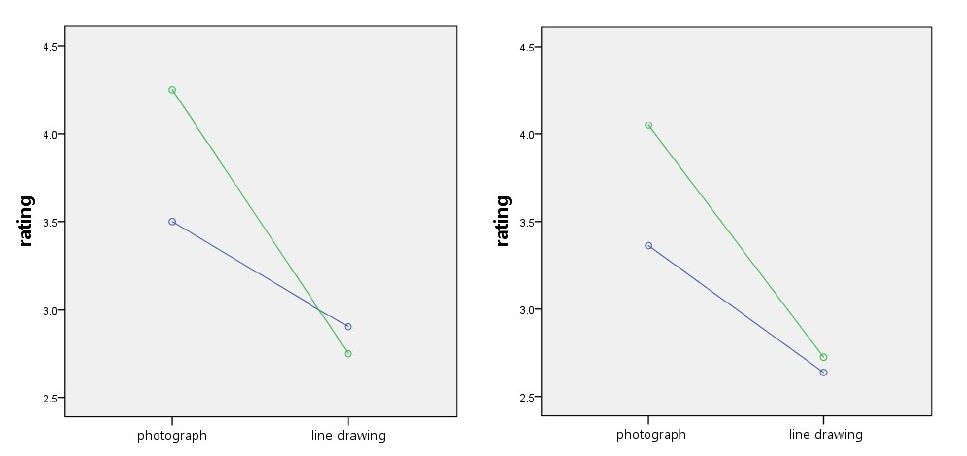
The ratings of major (blue) and non-major (green) groups in response to question A3 (explorable) (left) and A_Total (right) with respect to photograph and line drawing. The non-major group reported a larger difference between representations than the major group, and photograph had a larger difference between major/non-major groups than line drawing
We also compared two eye-tracking parameters – fixation count and mean fixation duration – between representations and major/non-major groups. When all images were combined, line drawing exhibited a higher fixation count and shorter mean duration, indicating faster jumps between fixations (Table 3-1, Figure 3). This trend was more pronounced in the major group than the non-major group (Table 3-2). The distinction of diverse vs. specific exploration (Berlyne, 1971) by educational training (Nodine et al., 1993) seems applicable to representation type as well.
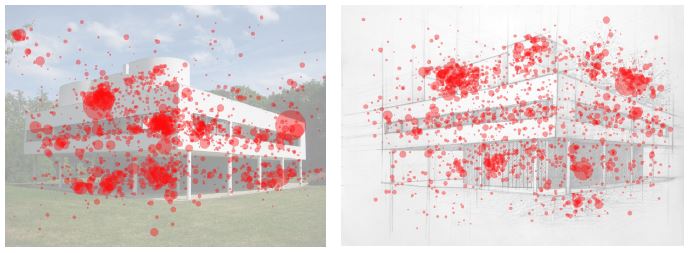
Visualization of fixations on a photograph (left) and a line drawing (right). The line drawing in general had greater and shorter fixations
4. 2. Single scene
To compare the level of concentration of viewers’ fixations between photography and line drawing, mean and standard deviation of cumulative fixation durations on 30 x 30 grid cells (Table 4-1) were used. As cells with no fixations were excluded, a higher mean could indicate (1) a higher total fixation duration and/or (2) more cells with no fixation. The number of cells with no fixation was more influential due to the comparable total fixation durations, as will be described in more detail later. Higher standard deviation comes from more cells further from the mean fixation duration. As the histogram of the fixation durations showed that the number of cells with longer fixation duration tended to decrease exponentially (Figure 4), it was estimated that the presence of strongly attended cells was the main source of high standard deviation. Guided by the color-coded fixation map and the ratios of mean and standard deviation, each pair of photograph-line drawing representations was investigated.
Figure 1(a): The mean fixation duration of the line drawing was 14% lower than the photograph, because of the increase in the number of fixated cells (12.8%), rather than the difference in the total fixation duration (-2.46%). This measure matched the fixation map where line drawing had been fixated more widely to trees, lawns, and scaffolding sketching lines (Figure 5). In terms of standard deviation, the photograph was higher, mainly because of the stronger concentration on the window area. One contradictory trend was a focus on trees in the line drawing that were largely ignored in the photograph. The way trees were illustrated in line drawing moved them to the visual foreground, despite their semantically secondary role (Figure 5 right).
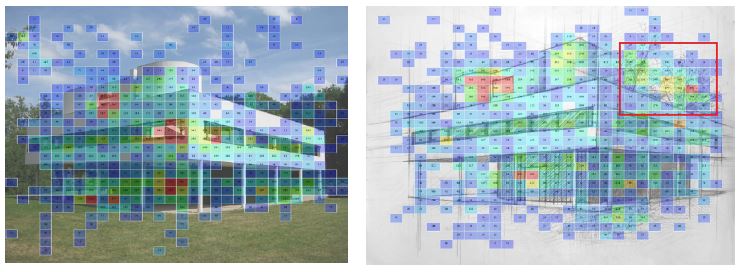
Fixation map of a photograph (left) and a line drawing (right) with cumulative fixation duration (100 ms unit) at 30 x 30 cells. The photograph had longer fixations, particularly on the windows of the second floor, whereas the line drawing had fixations spread across broader areas. The trees in the line drawing received substantial attention as compared with those in the foreground house area (red box)
Figure 1(b): The mean fixation durations were similar, as both the total number of fixated cells and fixation durations were comparable (Table 4-1). Unlike Figure 1(a), the standard deviation was higher in the line drawing, indicating that fixations were concentrated on fewer cells. The fixation map showed that the high attention near the center of the photograph shrank to fewer cells in the line drawing, and that mid-level attention spread to the larger area also congregated on human faces and signage (Figure 6). The lower level of detail of the line drawing reduced the fixation duration of the most highly attended areas and also concentrated the lower level attention to form new highly attended areas.
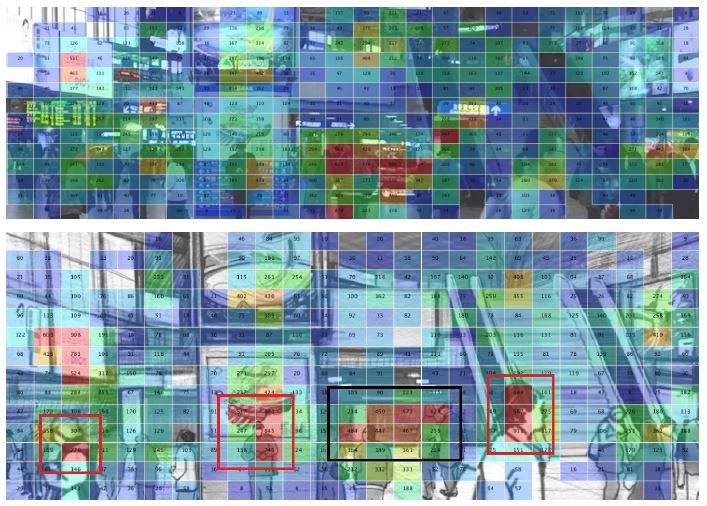
Comparison of a line drawing (below) against a photograph (top) shows that the most highly fixated area shrank (black box), while new peaks emerged (red box). The mid-level attention spread across the overall image area in the photograph congregated to form new high-level attention in the line drawing
Figure 1(c): The mean and standard deviation of fixation duration were highly comparable, and the attended regions also largely matched.
Figure 1(d): Line drawing had smaller mean fixation duration by 12%, due to the increase in the total number of fixated cells (11.5%), rather than the difference in total fixation duration (-1.9%). Standard deviation was also less in the line drawing, mainly due to the higher attention paid to sculptures at the base and the recessed area under the arch in the photograph (Figure 7). These regions commonly included complex and detailed shapes in contrasting shades whose rendition in the line drawing was limited due to resolution and color.
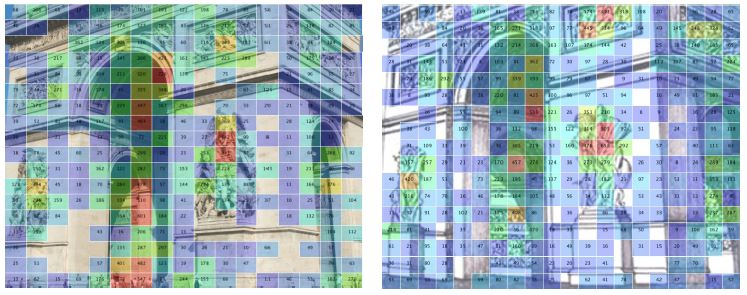
Both representations received high attention to the complex shapes, but the photograph had more attention along the boundaries of the contrasting shades
Figure 1(e): The mean and standard deviation of fixation duration were similar, as in image pair 3, but the center of the highest attention moved from the ground features in the photograph (e.g. doors, balconies, windows) to the roof structure in the line drawing (Figure 8).
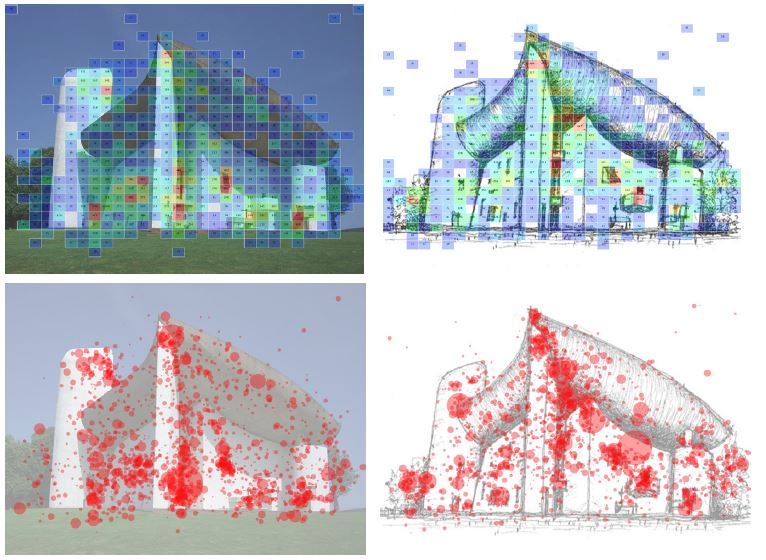
Fixation map of 30 x 30 cells (top row) and fixations at true locations (bottom row). The longer fixations moved from the ground level in the photograph to the roof structure in the line drawing
Figure 1(f): While the fixations were shorter and concentrated on a smaller number of cells in the line drawing, there were two opposite trends as to the simulated light. The window in the left of the image was given longer attention in the photograph, while windows on the right were given longer attention in the line drawing (Figure 9). The former had smudged edges for simulating the diffusion effect, whereas the latter had cleaner boundaries separating the shaded surfaces. Strong lighting that fades the underlying structure seems to discourage visual attention regardless of the representation.

The window on the left had longer attention in the photograph (left) than in the line drawing (right). On the contrary, those on the right received longer attention in the line drawing than in the photograph
In summary, (1) foreground objects in general were given higher attention compared to background objects, but their relative order could be changed by their rendition in the line drawing (trees in Figure 5 and the roof in Figure 8), and sometimes the sketch line itself became the focus of attention (Figure 5 right). (2) The reduction of the level of detail in the line drawing resulted in the decrease of high fixations, particularly near information-intensive areas (Figure 6) or complex shapes (Figure 7). (3) Lighting attracted attention to itself particularly near the high contrast shade (Figure 7), but strong brightness that blinded the underlying structure detracted attention (Figure 9).
Table 4-2 shows the mean and standard deviation of fixation duration per major and non-major group, estimating the impact of major/non-major groups on the representational effect in Table 4-1. The following qualitative analysis based on 10x10 cell visualization was supplemented by fixation visualization in order to minimize the effect of an individual on the group comparison; no single individual concentrated to a single region so much as to invalidate the group difference.
Figure 1(a): Table 4-2 shows that the mean and standard deviation of fixation duration of the photograph by the major group was significantly higher than the others: the photograph by the non-major group and the line drawing by both groups. In other words, the higher mean and standard deviation of the photograph in Table 4-1 are attributable to the major group. Figure 10(a) shows that in the photograph, the major group concentrated more on the house itself, whereas the non-major group spread more widely to the surrounding environment. As for the line drawing, Figures 10(b) and 10(c) show that the non-major group fixated longer on the trees than the major group, suggesting that the higher attention to trees in Figure 5 came from the non-major group.
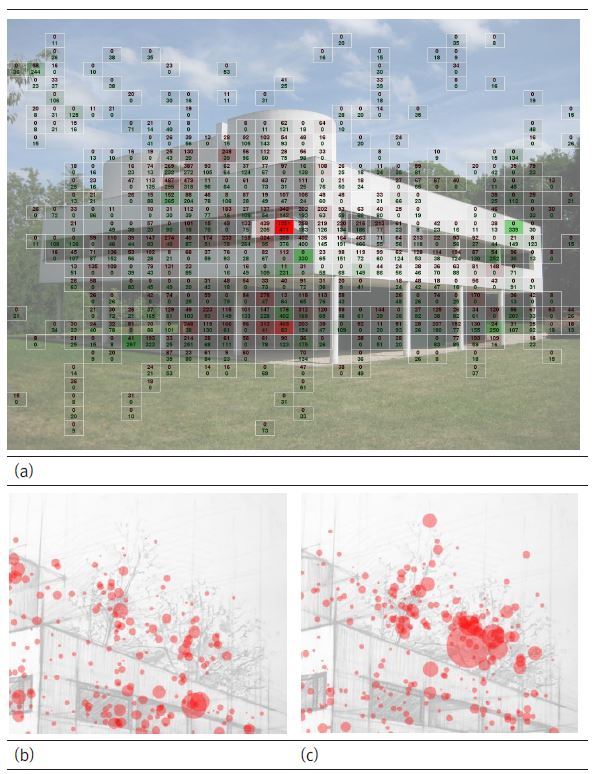
(a) Visualization of the difference in fixated areas between major and non-major groups. More transparent cells indicate a lower difference of the cumulative fixation duration. The major group attended relatively more to the house area (red), whereas the non-major group looked more widely at the surrounding environment (green). In the line drawing, the major group (b) fixated less on the trees than the non-major group (c)
Figure 1(b): The standard deviation of fixation on the line drawing by the non-major group was substantially higher than the others: the line drawing by the major group and the photograph by both groups (Table 4-2). The non-major group concentrated most strongly on human faces and commercial signage in the line drawing, whereas the major group attended relatively longer to the cluttered area near the center of the image and the second floor at the top of the image, regardless of the representation (Figure 11(a)). This indicates that the shift of focus from mid-level attention in the photograph to faces and signage in the line drawing (Figure 6) was stronger in the non-major group.
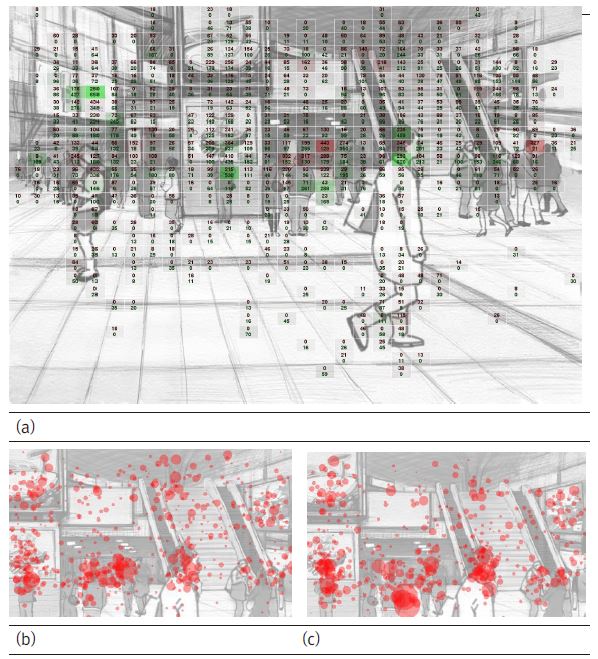
(a) Overall, the non-major group spent more time on human faces and signage (green), whereas the major group fixated on the cluttered area in the middle and the second floor (red). (b) and (c) visualize the actual fixations by major and non-major group, respectively
Figure 1(c): The non-major group had substantially higher standard deviation than the major group for both representations (Table 4-2). The non-major group was strongly attracted to entourage objects, such as the fire extinguisher, toilet sign, and textual signboard, whereas the major group tended to divide their attention more widely among the stairs, columns, and ceilings (Figure 12).
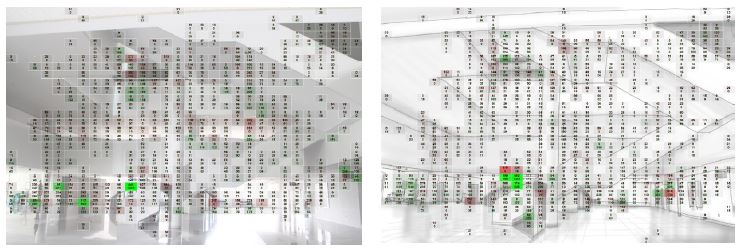
Differences in visualization between major and non-major groups for the photograph (top) and the line drawing (bottom). The non-major group strongly concentrated on the objects on the first floor (green), whereas the major group had fixations covering the entire image area (red)
Figure 1(d): The standard deviation was lower in the line drawing for both groups (Table 4-2), most likely due to the lower resolution and grayscale color. One observation from the photograph was that the major group divided their attention more evenly with respect to the symmetry axis of the arch (right/left = 2.36) than the non-major group (4.86) (Figure 13). This finding is in accordance with a previous study that artists are more sensitive to aesthetic balance (Nodine et al., 1993). Such result was not applicable to the line drawing, where the non-major group (2.74) was more balanced than the major group (3.06) by a smaller margin.
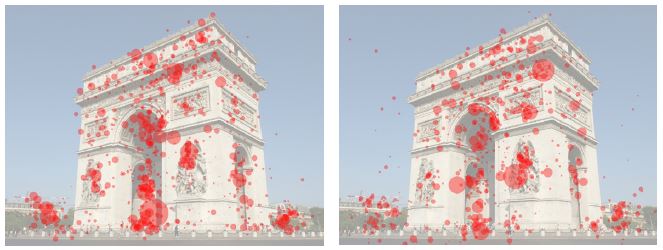
The total fixations on the main face of the arch were more evenly divided with respect to the symmetric axis by the major group (left) than the non-major group (right)
Figure 1(e): Although there was no distinct trend in the mean or standard deviation, one finding from the photograph was that the major group focused more on the vertical wall at the center of the image, whereas the non-major group stayed longer on the balconies, windows, and doors (Figure 14(a, b)). One interpretation is that the major group tried to resolve uncertainties near the joints, whereas the non-major group experienced the view as a residential structure. The division by major/non-major groups was reduced in the line drawing (Figure 14(c, d)), where both groups moved their foci up to the roof (Figure 8).
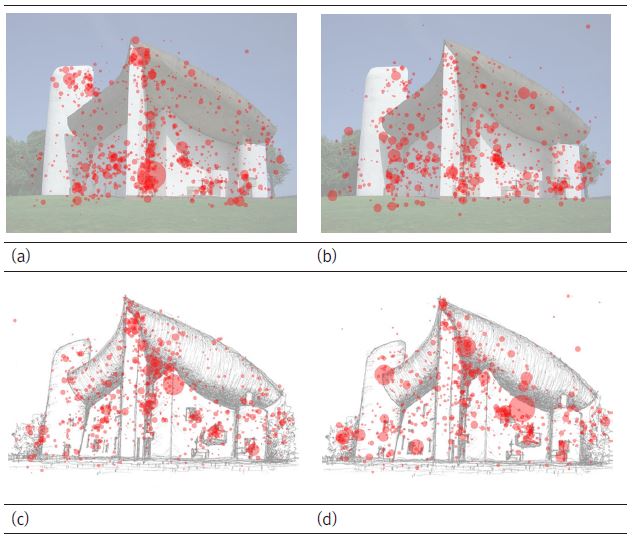
Fixations of the major (a, c) and non-major group (b, d) for the photograph (a, b) and the line drawing (c, d). In the photograph, the major group concentrated more on the vertical wall at the center of the image (a), whereas the non-major group had a spread view covering the shades, balconies, windows, and openings (b). Such division between the major/non-major groups was less clear in the line drawing, where both had their foci on the roof structure (c, d)
Figure 1(f): The major group attended more to the slit between the wall and the ceiling, and openings at the center and right end of the image. The non-major group attended more to humans and entourage objects: the altar, statue, pew, and flowers. This division was again clearer in the photograph than in the line drawing (Figure 15).
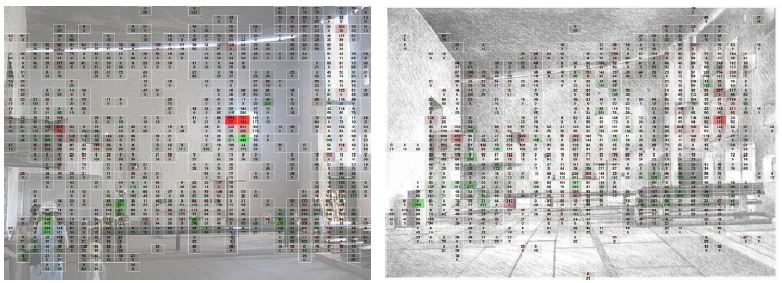
The relative strength of attention by major (red) and non-major group (green) is higher in the photograph (left) than in the line drawing (right)
In summary, attention by both groups was distinguishable mainly by where the participants focused. The major group attended to the structural elements (the house itself, stairs, columns, and walls), whereas the non-major group attended to the surrounding environment and architectural entourage (humans, signage, and signboards). Such finding provides a ground for why the major group was more sensitive to reading symmetry and resolving structural uncertainties. The division was clearer in the photographs than in the line drawings with remarkable consistency, according to both fixation maps and the higher differences in cell fixations between the two groups for photographs (Table 4-3).
4. 3. Changes in architectural environments
We then sought to identify the impact of representation on the shift of visual attention, in response to a change in the architectural environment. As stimuli, image pairs with columns and stairs (Figure 1(a, b, c)) were chosen. The difference of fixation durations between images with and without target elements was measured and then the direction in which attention had shifted was visually inspected.
Figure 1(a, g): When the difference of fixation durations between images with and without the columns on the first floor was compared, the line drawing had a larger difference than the photograph (5.9%), but the absolute gap was significantly smaller than the others, Figure 1(b, h) (-14.7%) and Figure 1(c, i) (-14.5%) (Table 5-1). In the photograph with the columns, fixations were more concentrated between the columns (first floor) or on the column itself (second floor) (Figure 16).

Sum of differences of fixation duration at 30 × 30 cells between images with and without architectural elements
Figure 1(b, h): The photograph had a greater overall difference of fixation duration than line drawing between images with and without stairs (Table 5-1). With the stairs, people attended more to the cluttered area at the center, the stairs itself, and the second floor. Without the stairs, fixations were spread more horizontally to nearby faces and signage. A similar but weaker shift was also found in the line drawing, as indicated by the lower saturation of colors in the fixation map (Figure 17).

With the stairs, viewers attended more to the cluttered area near the center of the image, the stairs, and the second floor (red). Without the stairs, viewers attended more to the human faces and signage (green). The difference is greater in the photograph (left) than in the line drawing (right)
Figure 1(c, i): As in the image pairs in Figure 1(b, h), the difference of fixation duration between images with and without the column was greater in the photograph than in the line drawing (Table 5-1). One notable difference was the uneven attention on the top right area in the photograph (red box in Figure 18), where the shadow of the middle column was projected. The area was fixated only when the middle column was present, and no such difference was found in the line drawing, due to the absence of the shadow information.
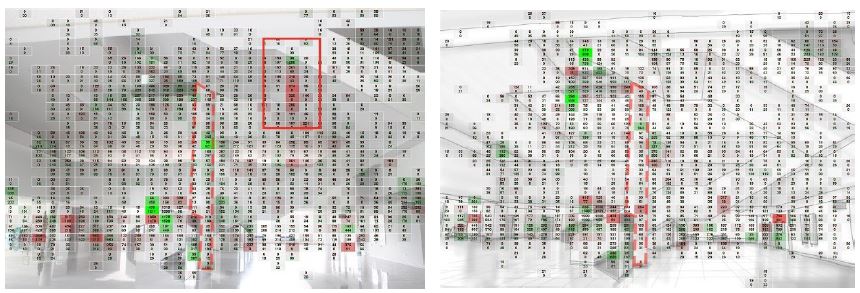
In the photograph (left), the shadow on the surface of the diagonal wall (red box) was fixated only when the column in the dashed red line was present
In summary, it was observed that (1) a closed boundary worked as a frame that contained fixations (Figure 16, 17), (2) diagonal elements were direct inducers of attention (Figure 17), and (3) vertical elements drew attention in combination with other parallel (Figure 18) or collinear (Figure 16) elements. Overall, line drawing representation tended to lessen the intensity of the effects, as suggested by the reduced difference in fixation duration (Table 5-1).
5. Conclusion
5. 1. Representational effect
As suggested by Table 4-1, there was no trend that favored either type of representation unanimously. Instead, the line drawing, in terms of simulating the photograph, both attracted and deflected visual attention. The first effect was the decrease in fixation duration near information-intensive areas, such as vanishing points, complex shapes, and high and sharp contrast. The unavoidable decrease in the level of detail lowered the amount of information to process, and therefore the fixation time. This reduction of high attention seems to be the dominant effect of line drawing, as suggested by the overall decrease in fixation duration (Figure 3).
The second effect of line drawing was the increase in visual attention as (1) selected elements (e.g., human faces, lighting, the roof) in the photograph became clearer or emphasized in the line drawing, and (2) the sketch lines per se increased attention on the background objects (e.g., lawn, sky, extending sketch lines). Although the former is essentially the reverse of the first effect in that it enhances the resolution, the latter occurs when the background objects perceptually filtered from the photograph are brought into visual foci by the expressional means. In terms of the distribution of attention between foreground and background, this second effect either polarized the difference by making the foreground objects even more visible or made the scene flatter by making the background objects harder to ignore.
From these observations, the challenge of simulating a photograph seems mostly technical: to maintain as much information as possible, try not to simplify too much, and keep the background as unnoticed as in the photograph. However, its application should be preceded by determining the relative order of attention among visual elements, with a consideration on factors such as information intensity (e.g. shape complexity, light contrast, crowdedness), transcendental (e.g. light and human faces) or symbolic nature (e.g. street signs), and the semantic role (background vs. foreground) of an object. Eye-tracking data can be utilized to reveal the distribution of attention on a particular scene, as demonstrated in an adaptive CG renderer (De Carlo & Santella, 2002). After that, various expressional means may apply: clarity of the lines (e.g. blurring, depth of focus, haze), emphasis via repetition or grayscale, and monotony of the patterns. We may turn to the history and state-of-the-art technology of computer graphics for aid, since it has developed numerous visual techniques for emulating reality in real-world images (Watt, 2000). The blurriness and homogeneity of the background, for example, will be simpler to control algorithmically than manually.
5. 2. Major and non-major groups
The effect of major/non-major group on visual perception emerged in the form of uneven attention on different object types. Unlike the non-major group, which attended more to the background and architectural entourage (e.g., vegetation, human faces, signage, chairs), the major group was more interested in architectural structures (e.g., stairs, columns, openings) and sought to read balance or resolve structural uncertainties. Another remarkable finding was that representation type had a solid impact on how major/non-major groups perceive differently. For all stimuli, the overall difference between the major and non-major group was greater in the photograph. This result is in line with the questionnaire, which found that the two groups were closer in opinion on perceived realism in line drawing, as opposed to photography. One explanation could be that longer fixations on the photographs were simply split and spread to the broader area in the line drawing, suggesting the minimal impact of the major/non-major distinction. Two counterexamples are that (1) fixations not only scattered but moved to a common area (Figure 1(e), 14) and (2), even when fixations were more concentrated in the line drawing, the difference between the two groups was smaller for the line drawing (Figure 1(b), Table 4-3).
We therefore speculate that line drawing weakens the typical reading pattern of the major group. They are influenced more easily by the intention to control visual attention, care less about symmetry, and lose the urge to read architectural structure in line drawing. According to Schumann et al. (1996), architects expressed their intention to participate more actively in a sketch rather than in a shaded rendering. They explained using the process of “projection of experience and expectation” by Gombrich (1986), which implies that sketches afford more room for interpretation, and therefore stimulate more active participation. Similarly, Bafna (2008) argued for the role of line drawing in its own right as an inducer of imaginative engagement. If the theory is extended to this study, the typical reading pattern of photographs by the major group represents a more automated reading mode, with less room for creative interpretation. This result implies that line drawing can be a better communication ground between major and non-major groups in terms of active discussion and participation.
5. 3. Responses to the changing environment
The most prominent effect of architectural elements on visual attention was framing, a tendency to fixate on areas within a closed boundary. This effect was strengthened by other contexts, such as rich information within the boundary and the existence of nearby distracting features (e.g., human faces). Another finding was the effect of diagonal elements in attracting visual attention (Lee et al., 2015; Weber et al., 2002). These effects were stronger in the photograph than in the line drawing, indicating that the photograph contains more contextual information combining visual elements, and is therefore more susceptible to environmental changes.
In conclusion, this study suggests that in order to manage discrepancy between representations, it is imperative to maintain the relative level of attention by applying an appropriate means of expression, along with a method to evaluate its overall impact on perception. As part of the research goal, the results also identified some practical drawing techniques with proven effects on visual perception. Despite all the present cases with varying levels of equivalences, one invariable factor was the difference between major and non-major groups across representations. Photographs elicited a more purposeful reading mode by the major group, which requires us to reconsider the view that line drawing is deemed substantially less credible by the public than experts, and inappropriate as a communicating media for decision-making (Bates-Brkljac, 2009). Unlike the survey the study is based on, the physiological measures in this study reveal that line drawing may have unique potential for fostering more open and less opinionated discussion.
One critical question is whether visual attention does reflect what people have in mind. This is the axiom of most eye tracker-based research, the eye–mind hypothesis (Just and Carpenter, 1980). While our survey results showed that both major and non-major groups have higher consensus with respect to the line drawing, an extensive survey will reveal whether their thoughts agree. We also acknowledge that the proposed study used a limited number of images as a target, and more studies should follow for broader exploration.
Acknowledgments
This work was supported by the National Research Foundation of Korea Grant funded by the Korean Government(NRF-2014S1A5A8012349)
Notes
Copyright : This is an Open Access article distributed under the terms of the Creative Commons Attribution Non-Commercial License (http://creativecommons.org/licenses/by-nc/3.0/), which permits unrestricted educational and non-commercial use, provided the original work is properly cited.
References
-
Anderson, A. T. (2002). On the human figure in architectural representation. Journal of Architectural Education, 55(4), 238-246.
[https://doi.org/10.1162/104648802753657941]

-
Appleyard, D. (1977). Understanding professional media: issues, theory, and a research agenda in I Altman and JF Wohlwill (eds) Human behavior and environment Vol 2 Plenum Press. New York, 43-88.
[https://doi.org/10.1007/978-1-4684-0808-9_2]

- Arnheim, R. (1954). Art and visual perception. Berkeley. University of California Press, Ltd, 197(4), 96-161.
- Arnheim, R. (1969). Visual thinking. Univ of California Press.
-
Bates-Brkljac, N. (2009). Assessing perceived credibility of traditional and computer generated architectural representations. Design Studies, 30(4), 415-437.
[https://doi.org/10.1016/j.destud.2008.10.005]

-
Bafna, S. (2008). How architectural drawings work-and what that implies for the role of representation in architecture. The journal of architecture, 13(5), 535-564.
[https://doi.org/10.1080/13602360802453327]

- Berlyne, D. E. (1971). Aesthetics and Psychology. New York: Appleton-Century-Crofts. 100.
-
Bishop, I. D., & Rohrmann, B. (2003). Subjective responses to simulated and real environments: a comparison. Landscape and urban planning, 65(4), 261-277.
[https://doi.org/10.1016/S0169-2046(03)00070-7]

-
Daniel, T. C. (1990). Measuring the quality of the natural environment: A psychophysical approach. American Psychologist, 45(5), 633-637.
[https://doi.org/10.1037/0003-066X.45.5.633]

-
Daniel, T. C., & Meitner, M. M. (2001). Representational validity of landscape visualizations: the effects of graphical realism on perceived scenic beauty of forest vistas. Journal of environmental psychology, 21(1), 61-72.
[https://doi.org/10.1006/jevp.2000.0182]

-
DeCarlo, D., & Santella, A. (2002, July). Stylization and abstraction of photographs. In ACM transactions on graphics (TOG) (Vol. 21, No. 3, pp. 769-776). ACM.
[https://doi.org/10.1145/566570.566650]

- Dong, Y., & Lee, K. (2008). A cross-cultural comparative study of users' perceptions of a webpage: with a focus on the cognitive styles of Chinese, Koreans and Americans. International Journal of Design, 2(2), 19-30.
-
Downes, M., & Lange, E. (2015). What you see is not always what you get: A qualitative, comparative analysis of ex ante visualizations with ex post photography of landscape and architectural project. Landscape and Urban Planning, 142, 136-146.
[https://doi.org/10.1016/j.landurbplan.2014.06.002]

-
Dupont, L., Antrop, M., & van Eetvelde, V. (2014). Eye-tracking analysis in landscape perception research: influence of photograph properties and landscape characteristics. Landscape Research, 39(4), 417-432.
[https://doi.org/10.1080/01426397.2013.773966]

-
Dupont, L., Ooms, K., Duchowski, A. T., Antrop, M., & Van Eetvelde, V. (2017). Investigating the visual exploration of the rural-urban gradient using eye-tracking. Spatial Cognition & Computation, 17(1-2), 65-88.
[https://doi.org/10.1080/13875868.2016.1226837]

- Ehmke, C., & Wilson, S. (2007, September). Identifying web usability problems from eye-tracking data. In Proceedings of the 21st British HCI Group Annual Conference on People and Computers: HCI... but not as we know it-Volume 1 (pp. 119-128). British Computer Society.
-
Fuente Suárez, L. A. D. L. (2016). Towards experiential representation in architecture. Journal of Architecture and Urbanism, 40(1), 47-58.
[https://doi.org/10.3846/20297955.2016.1163243]

- Goel, V. (1995). Sketches of thought. MIT Press.
-
Goldschmidt, G. (2004). Design representation: Private process, public image. In Design representation (pp. 203-217). Springer, London.
[https://doi.org/10.1007/978-1-85233-863-3_9]

- Gombrich, E. H. (1986). Art and Illusion. Belser Verlag, Zurich.
- Hewitt, M. (1985). Representational Forms and Modes of Conception; an Approach to the History of Architectural Drawing. Journal of Architectural Education, 39(2), 2-9.
-
Hubbard, P. (1996). Conflicting interpretations of architecture: an empirical investigation. Journal of Environmental Psychology, 16(2), 75-92.
[https://doi.org/10.1006/jevp.1996.0007]

- Jansen, S., Boumeester, H., Coolen, H., Goetgeluk, R., & Molin, E. (2011). The effect of presentation: What you see is what you value. Journal of Architectural Planning Research, 28(3), 181-193.
-
Kalay, Y. E. (2006). The impact of information technology on design methods, products and practices. Design studies, 27(3), 357-380.
[https://doi.org/10.1016/j.destud.2005.11.001]

-
Koutamanis, A. (2000). Digital architectural visualization. Automation in Construction, 9(4), 347-360.
[https://doi.org/10.1016/S0926-5805(99)00018-7]

- Kukkonen, S. (2005). Exploring eye tracking in design evaluation. Joining Forces, 119-126.
- Laseau, P. (2001). Graphic thinking for architects and designers. John Wiley & Sons.
- Lee, S., Cinn, E., Yan, J., & Jung, J. (2015). Using an eyetracker to study three-dimensional environmental aesthetics: The impact of architectural elements and educational training on viewers' visual attention. Journal of Architectural and Planning Research, 32(2), 145-167.
-
Lewis, J. L. (2012). More art than science: the sources and effects of stylistic variation in visualization for planning and design. Environment and Planning B: Planning and Design, 39(3), 551-565.
[https://doi.org/10.1068/b37148]

-
MacFarlane, R., Stagg, H., Turner, K., & Lievesley, M. (2005). Peering through the smoke? Tensions in landscape visualisation. Computers, Environment and Urban Systems, 29(3), 341-359.
[https://doi.org/10.1016/j.compenvurbsys.2004.05.006]

-
Mahdjoubi, L., & Wiltshire, J. (2001). Towards a framework for evaluation of computer visual simulations in environmental design. Design Studies, 22(2), 193-209.
[https://doi.org/10.1016/S0142-694X(00)00027-2]

-
Miall, R. C., & Tchalenko, J. (2001). A painter's eye movements: A study of eye and hand movement during portrait drawing. Leonardo, 34(1), 35-40.
[https://doi.org/10.1162/002409401300052488]

-
Nodine, C. F., Locher, P. J., & Krupinski, E. A. (1993). The role of formal art training on perception and aesthetic judgment of art compositions. Leonardo, 26(3), 219-227.
[https://doi.org/10.2307/1575815]

-
Pietsch, S. M. (2000). Computer visualisation in the design control of urban environments: a literature review. Environment and Planning B: Planning and Design, 27(4), 521-536.
[https://doi.org/10.1068/b2634]

-
Rahman, O. M. A. (1992). Visual quality and response assessment: an experimental technique. Environment and Planning B: Planning and Design, 19(6), 689-708.
[https://doi.org/10.1068/b190689]

-
Reid, T. N., MacDonald, E. F., & Du, P. (2012, August). Impact of product design representation on customer judgment with associated eye gaze patterns. In ASME 2012 International Design Engineering Technical Conferences and Computers and Information in Engineering Conference (pp. 749-762). American Society of Mechanical Engineers.
[https://doi.org/10.1115/DETC2012-70734]

-
Ren, X., & Kang, J. (2015). Interactions between landscape elements and tranquility evaluation based on eye tracking experiments. The Journal of the Acoustical Society of America, 138(5), 3019-3022.
[https://doi.org/10.1121/1.4934955]

- Schön, D. A. (1983). The Reflective Practitioner. New York: Basic Books.
- Schumann, J., Strothotte, T., Laser, S., & Raab, A. (1996, April). Assessing the effect of non-photorealistic rendered images in CAD. In Proceedings of the SIGCHI conference on human factors in computing systems (pp. 35-41). ACM.
- Sheppard, S. R. J. (1989). Visual simulation: a user's guide for architect, engineers, and planners. New York : Van Nostrand Reinhold.
-
Sheppard, S. R. (2001). Guidance for crystal ball gazers: developing a code of ethics for landscape visualization. Landscape and urban planning, 54(1-4), 183-199.
[https://doi.org/10.1016/S0169-2046(01)00135-9]

-
Slater, M., Usoh, M., & Steed, A. (1994). Depth of presence in virtual environments. Presence: Teleoperators & Virtual Environments, 3(2), 130-144.
[https://doi.org/10.1162/pres.1994.3.2.130]

-
Vogt, S., & Magnussen, S. (2007). Expertise in pictorial perception: eye-movement patterns and visual memory in artists and laymen. Perception, 36(1), 91-100.
[https://doi.org/10.1068/p5262]

- Ware, C. (2012). Information visualization: perception for design. Elsevier.
- Watt, A. H., & Watt, A. (2000). 3D computer graphics (Vol. 2). Reading: Addison-Wesley.
- Weber, R., Choi, Y., & Stark, L. (2002). The impact of formal properties on eye movement during the perception of architecture. Journal of Architectural and Planning Research, 19(1), 57-69.
-
Wergles, N., & Muhar, A. (2009). The role of computer visualization in the communication of urban design - A comparison of viewer responses to visualizations versus on-site visits. Landscape and Urban Planning, 91(4), 171-182.
[https://doi.org/10.1016/j.landurbplan.2008.12.010]

- Wood, W. (1972). An analysis of simulation media (Unpublished master's thesis). Vancouver, School of Architecture, University of British Columbia.
-
Yu, R., & Gero, J. (2017, January). Exploring designers' cognitive load when viewing different digital representations of spaces: A pilot study. In International Conference on Research into Design (pp. 457-467). Springer, Singapore.
[https://doi.org/10.1007/978-981-10-3518-0_40]

-
Zobel Jr, R. W. (1995). The representation of experience in architectural design. Presence: Teleoperators & Virtual Environments, 4(3), 254-266.
[https://doi.org/10.1162/pres.1995.4.3.254]

-
Zube, E. H., Simcox, D. E., & Law, C. S. (1987). Perceptual landscape simulations: history and prospect. Landscape journal, 6(1), 62-80.
[https://doi.org/10.3368/lj.6.1.62]

